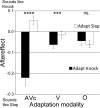Visual adaptation enhances action sound discrimination
- PMID: 27604284
- PMCID: PMC5179587
- DOI: 10.3758/s13414-016-1199-z
Visual adaptation enhances action sound discrimination
Abstract
Prolonged exposure, or adaptation, to a stimulus in 1 modality can bias, but also enhance, perception of a subsequent stimulus presented within the same modality. However, recent research has also found that adaptation in 1 modality can bias perception in another modality. Here, we show a novel crossmodal adaptation effect, where adaptation to a visual stimulus enhances subsequent auditory perception. We found that when compared to no adaptation, prior adaptation to visual, auditory, or audiovisual hand actions enhanced discrimination between 2 subsequently presented hand action sounds. Discrimination was most enhanced when the visual action "matched" the auditory action. In addition, prior adaptation to a visual, auditory, or audiovisual action caused subsequent ambiguous action sounds to be perceived as less like the adaptor. In contrast, these crossmodal action aftereffects were not generated by adaptation to the names of actions. Enhanced crossmodal discrimination and crossmodal perceptual aftereffects may result from separate mechanisms operating in audiovisual action sensitive neurons within perceptual systems. Adaptation-induced crossmodal enhancements cannot be explained by postperceptual responses or decisions. More generally, these results together indicate that adaptation is a ubiquitous mechanism for optimizing perceptual processing of multisensory stimuli.
Keywords: Action; Adaptation; Audition; Crossmodal; Discrimination; Multimodal; Perception; Vision.
Figures





References
-
- Barlow HB, Foldiak P. Adaptation and decorrelation in the cortex. In: Durnin R, Miall C, Mitchison GJ, editors. The computing neuron. Wokingham: Addison-Wesley; 1989. pp. 54–72.
MeSH terms
LinkOut - more resources
Full Text Sources
Other Literature Sources

